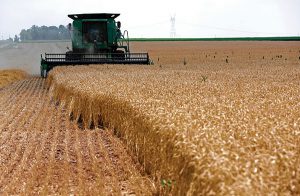Bloomberg
The US is poised to deliver a bumper spring wheat crop in the upcoming weeks, which if realized could help relieve global shortfalls caused by turmoil in the Black Sea.
Fields in North Dakota, the top producing US state, are forecast to yield a record high 49.1 bushels per acre of the grain, according to the final estimate of a three-day crop tour led by the Wheat Quality Council. North Dakota makes up about half of the US’s spring wheat crop.
The world is counting heavily on American farm supplies to help refill grain silos as Russia’s invasion of Ukraine continues to put more than a quarter of global wheat exports at risk. While all signs now point to an ample harvest, weather woes caused growers to plant the crop later than normal. The timing has made the wheat highly vulnerable to late-season problems that could still hurt production.
“We might have good yield potential right up until the day we get an early frost,†said Neal Fisher, administrator
of the North Dakota Wheat Commission.
Millers and master bakers like Ed Reinwald were on the lookout this week for signs of grains that can offer desired protein levels and other qualities prized by producers of pizza doughs, croissants and other specialty bread items.
“I’m pretty excited for this year’s crop,†said Reinwald, a crop scout and senior technical service manager in Albany, New York, for Ardent Mills, which provides flour for major food companies across the US.
This year’s spring wheat has been under close watch for potential problems after plantings were slowed by downpours and flooding throughout the northern Plains. The delays followed last year’s severe drought that shrank harvests in both the US and Canada.
Farmers were able to catch up, however, and largely favourable weather since then has eased supply worries. The crop tour’s outlook for North Dakota is slightly below the US Department of Agriculture’s initial yield estimate of 51 bushels an acre, which would be a jump from last year’s 33.5 bushels an acre.
Spring wheat has fallen about 33% from the highest in more than a decade reached in May, though any sign of problems while the wheat is still in the ground could send prices soaring again and revive food inflation pressures. Futures reversed early gains to slip as much as 0.4%.
“Six weeks from harvest for a lot of these fields is a long time, it’s an eternity,†said Dave Green, executive vice president at the Wheat Quality Council.
“We are worried a weather change or a pattern change could disrupt what otherwise looks to be like a very
outstanding crop.â€
 The Gulf Time Newspaper One of the finest business newspapers in the UAE brought to you by our professional writers and editors.
The Gulf Time Newspaper One of the finest business newspapers in the UAE brought to you by our professional writers and editors.
